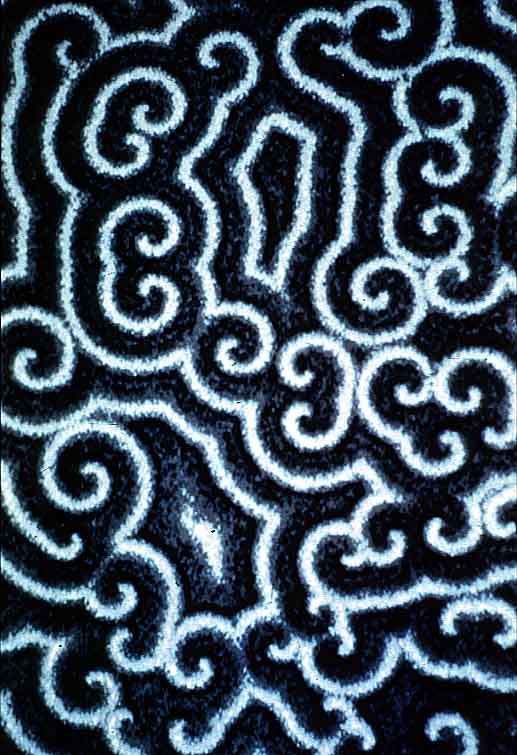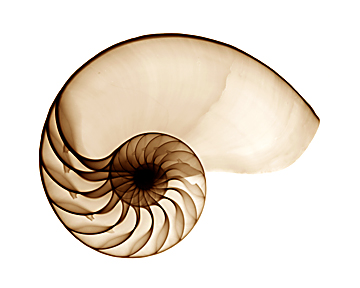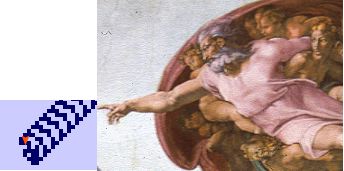Remote Ready Biology Learning Activities has 50 remote-ready activities, which work for either your classroom or remote teaching.
Serendip is an independent site partnering with faculty at multiple colleges and universities around the world. Happy exploring!

| 
| Exploring Emergence |
 |
 |

So far we've looked at the world of Langton's ant in terms of an agent, an environment, an observer/participant, and their interactions. And we know a fair amount at this point about how/why the world changes as it does. Is there anything more involved in that world that we need to think about/might learn something from? Supposed we've observed a clock to see what it does and taken it apart to see how it does it .... what other questions might we ask? An obvious one is where did the clock come from? How did it come to be the way it is? Are those useful questions to ask? In this case? Generally? How about if we're interested in this case for what we can learn about "purpose"?
Langton's ant looks to an observer (at least some) as if it has a "purpose" but turns out to have inside itself only a simple set of four instructions none of which say anything at all about building a road. In fact, as we've discovered, the road building doesn't follow inevitably from the instructions at all; it results from a bidrectional interaction between the ant and its environment. So where did road-building and "purpose" come from?
Most people presume that if something acts like it has a "purpose" (a clock to tell time?) that such a purpose must, if it can't be found in the thing itself, have been in the mind of the creator of the thing (the designer of the clock?). And the world of Langton's ant is of course not a "natural" thing but an "artificial" one. Did Chris Langton have in mind to build something that builds a road? that has a purpose? Did he put the world together to achieve one or the other of those?
We should really ask Chris that question (and will) but our guess is that Chris was as surprised at the road building as you were when you first saw it, that he didn't have road building on his mind at all when he created the world. We suspect Chris was just fiddling with possible sets of simple instructions and discovered that a particular set of instructions did something interesting. Whether that's actually true or not, the important thing is that it COULD have been true. The ingredients for the world of Langton's ant are simple enough so that one could have discovered that one of them does something interesting just by fiddling around and trying out various combinations.
Try it out. Above is version of the world of Langton's ant that will allow you to yourself create different worlds by changing the instructions in the ant. Remember that the ant goes forward, turns left or right depending on the color its on, and changes dark squares to light squares and vice versa. What happens if you change the instructions about which way to turn? About how to change the colors? You can find out by clicking on the red triangles in the control panel to the left and selecting options from the pull down menus. There are sixteen possible instruction sets for the ant (four distinct possible combinations of turn direction and color change for what happens on a dark square multiplied by the same four possibilities for what happens on a light square). How many give interesting behavior? Play with it and see whether you think Langton could have come up with the particular world he did just by fiddling.
Can you come up with other interesting worlds? Using the right control panel you can vary how many forward steps the ant takes on each turn. And you can add randomness to the ant's movements (see next section). You can even pick up the ant and move it elsewhere (click Start/Stop, then "Move Ant", and then click and drag the ant itself). You can also change the environment in various ways. Play with the possibilities (and let us know if you find something interesting).
There's an important general lesson here. Clearly at least some fairly sophisticated behavior, even behavior that looks "purposeful", can arise without a designer or planner or architect who has that particular behavior in mind. It requires only some fairly simple interactions and some fiddling. That's certainly not true of a watch or many other human creations. Clearly in many cases of human creations, some one had a particular outcome in mind and that was a key element in its being put together in the particular way it was and hence in its acting the particular way it does. But that's not always true for human creations (like Lanton's ant, or a jazz improvisation?). And it is worth wondering whether it is or isn't true for "natural" things (solar systems, trees, humans) that humans don't deliberately construct. Maybe "purpose" can arise without "purpose"? Just from some kind of natural "fiddling" with simple interactions of simple things?
So, it IS useful to ask how things came to be the way they are, in general and in this case. And the answer MAY be that there was an architect/planner/designer who had in mind an intention or blueprint and built something based on that. But its also possible that things can come into existence without any PARTICULAR blueprint, just by some fiddling with a general idea in mind (to make something new and "interesting"?). And maybe its even possible that things could come into existence just by anything that fiddles regardless of whether there is a mind there at all? Let's have a look at that idea.
| "The World of Langton's Ant" was produced by Paul Grobstein with the Summer 2005 Serendip/SciSoc group. Applets were created with NetLogo by Rebekah Baglini, building on earlier work. Our thanks to the Emergent Systems Working Group for fertile conversations from which this emerged and to which we hope it further contributes. |
Watching Looking Inside Agents/Environments | Observers | Architects | Beyond Determinism? Summary and ... Further reflections on Emergence and Science Education |